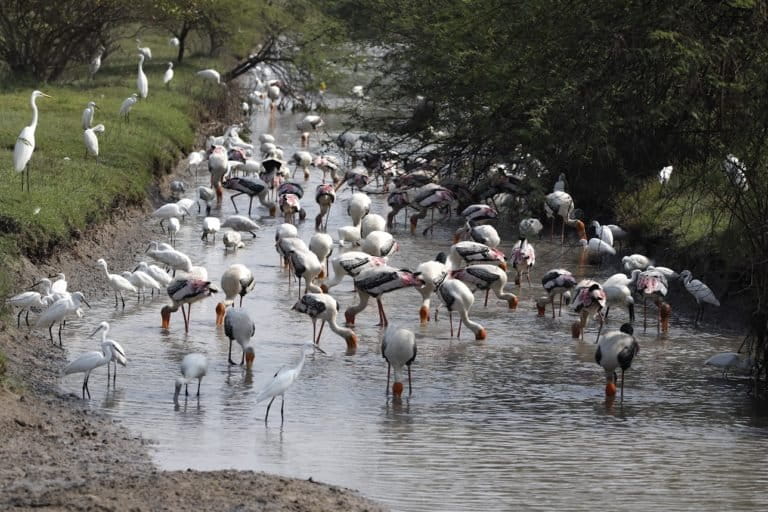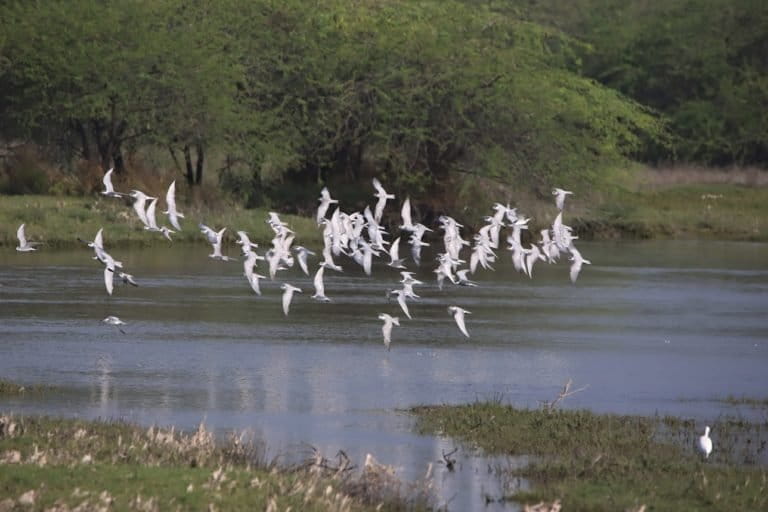- Wetlands in Tamil Nadu are important biodiversity hotspots, serving as vital habitats for a diverse array of plants, birds and animals, which include many species that are at risk.
- Land conversion, pollution, invasive species, alteration to natural water levels and climate change pose as threats to Tamil Nadu’s wetlands. The state needs an innovative wetland conservation strategy with an integrated approach and a shared commitment among all sectors.
- The Kazhuveli wetland, Tamil Nadu’s 16th bird sanctuary, is an important wintering ground for several thousand waterbirds and shorebirds during the migration period and needs a special attention.
- The views in the commentary are that of the author.
Wetlands, which connect land and water are among the planet’s most productive and diverse habitats. They play a significant role in shaping our biosphere. Wetlands in the coastal state of Tamil Nadu are important biodiversity hotspots, serving as vital habitats for a diverse array of plants, birds and animals, which include many species that are at risk. The vast inland wetlands in the state are not only vital in supporting valuable rich biodiversity, but also provide economic benefits and contribute to livelihoods. An effective wetland conservation strategy is essential to guide and ensure the sustenance of wetland conservation in Tamil Nadu.
First, the conservation framework should begin with a scientific documentation of the current condition of the wetlands and the applicable legislation, regulations, policies, guidelines, programmes and partnerships. Second, the wetland conservation strategy should delineate a clear vision, goals, a timeline and the desired outcomes. Also, the strategy needs to include the participation of various societal segments, not only water and biodiversity experts and government officials but also the public and the local communities.
Tamil Nadu is bestowed with more than 9,02,534 hectares of wetlands. This places the state in a unique position. Thus, it is entrusted with a high responsibility to protect these wetlands for the current and future generations.

Wetlands and their critical functions
Broadly, wetlands are lands submerged periodically or permanently in water or where the water table is close to the surface formation of hydric (waterlogged) soils and favours the dominance of either hydrophytic or water-tolerant plants. The four major types of wetlands are swamps, marshes, bogs and fens. They are often transitional forming explicit as well as implicit and intricate linkages between aquatic and terrestrial ecosystems. Wetlands range from very small to exceptionally large sizes. Wetlands may also be partially isolated, occurring along the edges of lakes and rivers or in conjunction with other natural areas such as woodlands, shrub-lands and native grasslands. Closely spaced wetlands are termed as a wetland complex.
The critical functions the wetlands play in nature include maintaining natural cycles, climate systems, water filtration, flood mitigation, erosion reduction, nutrient cycling, groundwater recharge/discharge, carbon sequestration, recreational, social, cultural, and spiritual opportunities. Healthy, biologically diverse wetlands provide multiple ecosystem services to people. Ecosystem services are defined as the benefits people obtain directly or indirectly from nature.
Read more: [Explainer] What are wetlands and why do we need to protect them?
Wetlands act as natural infrastructure, producing economic benefits every year for humans. The economic valuation of wetlands offers us a way to communicate and understand the benefits derived from the wetlands. The financial cost of a major flood event on humans could be considerably reduced by leaving wetlands intact, and investment in wetland conservation is prudent as the costs of various services derived from nature would be much lower than when human-made infrastructure used for the same purpose.
Fragmentation of Tamil Nadu’s wetlands
Tamil Nadu was once known as a vast network of contiguous forests, lakes, rivers and wetlands. However, the landscape has undergone drastic changes in response to various economic and resource-use opportunities. According to a study done by Care Earth Trust (a Chennai-based biodiversity research organisation), only 15% of Chennai’s wetlands are left, down from the 80% in the 1980s. Recent assessments have shown that the loss rate appears to be increasing. While land conversion is the primary cause of wetland loss in Tamil Nadu, pollution, invasive species, alteration to natural water levels and climate change also pose grave threats.
Tamil Nadu’s inland and coastal wetlands have experienced substantial historical losses and degradation over the past 200 years. Loss and degradation continue today, mainly from shoreline alteration, water level control, nutrient and sediment loading, invasive species, dredging, and development.
In addition to loss and degradation, wetlands in the northern part of Tamil Nadu are generally under pressure, and the threats are quite different from those in southern Tamil Nadu. Apart from urban development and drainage for agriculture pressures, mining, hydroelectric and alternative energy development, and transportation infrastructure. A warmer and drier climate may reduce many wetlands in size, convert some to dry land, or transform one wetland type into another.
Bogs and fens, which depend on precipitation and surface runoff rather than groundwater, are especially sensitive to drying. Peatlands are also likely to become dry due to increased evapotranspiration. Water-level fluctuation is the most crucial factor that strongly influence wetlands’ structure and function. Increased runoff during severe rain may alter these ecosystems. Alternatively, reduced water levels may eliminate wetlands or affect their ability to maintain shoreline integrity, reduce erosion, filter contaminants, and provide habitat to fish and wildlife. Forested wetlands and peatlands are especially important because they store significant amounts of carbon.
Invasive species also have a profound impact on wetlands. To address this issue, the Tamil Nadu government must develop appropriate invasive species removal measures to prevent, detect, control and eradicate such species. Buying, selling, transporting, or propagating invasive species should be restricted. Prosopis juliflora (known as the karuvai in Tamil) has a negative impact on coastal wetlands in Tamil Nadu. This species spreads rapidly and creates dense, thick clusters, disrupting sensitive wetland ecosystems and putting a significant percentage of species at risk. The government should assist local bodies and community groups by funding the control of Prosopis juliflora, with the help of the Forest Department and other conservation groups. A pilot project to test non-chemical means of eradication in wetland areas to combat Prosopis juliflora should also be tried.
The wetland of Kazhuveli and why it needs protection
The Kazhuveli or Kaliveli wetland has been declared as the 16th bird sanctuary of the state under subsection (1) of section 18 of the Wildlife (Protection) Act, 1972. Located in the Villupuram district of Tamil Nadu, the Kazhuveli wetland is the third largest brackish water lake in south India. The bird sanctuary lies adjacent to the Bay of Bengal along the east coast of Tamil Nadu.

Initially, the southern part of the wetland was declared a reserved land in 2001. The sanctuary spans 13 villages in the Villupuram district. This proclaimed sanctuary and ecologically important wetland, home to a range of diverse species of flora and fauna, is a habitat for several long-distance migratory birds in the Central Asian Flyway.
About 226 species of birds belonging to 59 families have been reported from Kazhuveli wetland, 39 percent of the bird species recorded in Tamil Nadu. The wetland is an important wintering ground for several thousand waterbirds and shorebirds during the migration period. Of the 59 families reported, Scolopacidae forms 9.7 percent of birds recorded for Kazhuveli.
The avian diversity at Kazhuveli







Kazhuveli supports four vulnerable and nine near-threatened bird species: greater spotted eagle (Clanga clanga), lesser adjutant (Leptoptilos javanicus), common pochard (Aythya ferina), river tern (Sterna aurantia), spot-billed pelican (Pelecanus philippensis), Asian dowitcher (Limnodromus semipalmatus), black-tailed godwit (Limosa limosa), bar-tailed godwit (Limosa lapponica), Eurasian curlew (Numenius arquata), black-headed ibis (Threskiornis melanocephalus), oriental darter (Anhinga melanogaster), painted stork (Mycteria leucocephala) and pallid harrier (Circus macrourus).
It is, therefore, vital that Tamil Nadu has an innovative Wetland Conservation Strategy with a concrete vision to monitor and ensure progress. It also needs to support provincial, regional, continental and international objectives for wetland conservation.
Read more: Birds in Delhi ponds remind us why we should not ignore small urban wetlands
Wetland conservation, requires an integrated approach and a shared commitment among all sectors, including the local bodies at the panchayat level. Wetland conservation strategy for Tamil Nadu has to be shaped with various partners, industries, academics, non-governmental organisations and other stakeholders. The successful implementation of a Wetland Conservation Strategy will also require fine-tuning to ensure the public and communities’ support, involvement, knowledge, innovations, and practices in a participatory (both in decision-making and execution) manner.
The strategy also should ensure that it is consistent with the constitutional protection provided for and treaty rights and supports the involvement of indigenous people. Wetland Conservation Strategy for Tamil Nadu should serve as a launching point for new, innovative conservation commitments and actions that can push the conservation efforts to a new level. The strategy should be a roadmap for wetland conservation in India.
Kannan Vaithianathan is Scientist, Terrestrial Ecology Division, Gujarat Institute of Desert Ecology, Bhuj, Gujarat.
Banner image: Painted storks in Kazhuveli. Photo by Bupesh Gupta.
